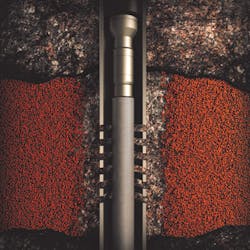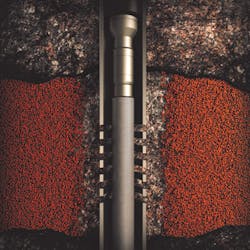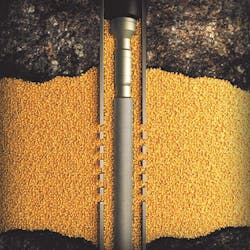New immobile proppant system bonds without closure stress
Daryl Johnson
CARBO
Operators that have been producing from wells in the deepwater Gulf of Mexico (GoM) will eventually require intervention to re-pressurize the reservoir to maintain an economically favorable production rate. After establishing water injection wells to aid with production, the operator can often find that the reservoir pressure depletion is at a level where they need to inject at rates in excess of 20,000-50,000 b/d.
During cased hole frac and pack (CHFP) stimulation, proppant fills the wings of the fracture, then the annulus between the casing and the screen. The annular pack provides a secondary barrier for sand control. Conventional proppant, over time, washes out of the annulus, creating voids and allowing the ingress of formation fines. Eventually, the connection to the fracture can be lost and the pressure needed to inject at the required rates becomes so high as to make injection economically unviable. Additionally, with conventional proppant a tracer was desirable, so that the propped fracture height could be determined and more importantly, a qualitative evaluation of the annular pack could be determined.
Conventional proppant unconsolidated pack. (All images courtesy CARBO)
Identifying an immobile proppant
With the objective to inject at ultra-high rates for many years and at pressures exceeding the parting pressure of the soft sand formations, two major operators approached CARBO with the challenge to develop a new type of immobile proppant system that would bond the highly conductive proppant pack in the formation and the annulus without closure stress. The project became known as Water Injection Soft Sands (WISS).
Twenty-nine different products and technologies were tested unsuccessfully before one technology passed all the rigorous immobile proppant WISS screening tests and went on to be successfully deployed in the field. The products were subjected to demanding test protocols that simulated every aspect of what the proppant would go through during pumping, placement, ultra-high rate injection and cyclic loading due to pressure pulses from shut-downs and start-ups.
The solution came from combining a new resin coating applied to a lightweight ceramic substrate, a chemical activator that could be run in the proppant slurry and an internal tracer placed inside the proppant during manufacturing. The solution became known as FUSION technology due to the combination of the four technologies.
FUSION proppant system consolidated pack.
Technology highlights
The FUSION specially formulated chemical activator was developed to enable the resin coating to bond in non-compressive and low-temperature environments (in the annulus as well as in the fracture), creating a high integrity pack that withstands stress cycling while sustaining long-term pack integrity and conductivity. As the FUSION coating also bonds with closure stress, it works to maintain the integrity of the proppant pack in the fracture. The bonded proppant in the fracture minimizes embedment in the formation face, prevents prop pack rearrangement and lowers the delta P across the pack. It also allows for a single resin-coated proppant and liquid additive activator to be used simultaneously in a continuous frac and pack operation. As the unique bonding process is chemically and temperature activated, the working time can be adjusted to allow any excess proppant in the workstring to be reversed out prior to the bonding of the proppant pack.
In the development of FUSION technology, CARBO created a proprietary method to evaluate the quality of the annular pack to establish where voids occurred in the pack. An inert, Non-Radioactive Tracer is added to the ceramic proppant ore and incorporated into the mix used to make each pellet. An added benefit of its non-radioactive status is that the proppant can be transported and used internationally without being subject to a complex permitting process.
This tracer technology, named as CARBONRT, is detected downhole by wireline tools and interpreted at surface. Furthermore, it is permanently detectable due to the fact it does not rely on radiation to be detected. For the entire life of the well, operators can re-log the well and determine annular pack integrity (including the creation of voids), near wellbore connectivity and propped fracture pack height.
Case studies: onshore
Three land-based test wells were gravel packed and a fourth injection was completed with FUSION technology during the development and qualification phases. Injection rates reached 25,000-30,000 b/d on these wells. CARBONRT was successfully used to evaluate both the propped frac height outside the casing and give a qualitative evaluation of the bonded proppant pack in the annulus between the screen and the casing.
Case studies: offshore
Two deepwater Gulf of Mexico wells were completed. Since 2014, well #1 has been on injection for more than 440 days with more than 400 days at injection rates exceeding parting (frac) pressure of the formation. The maximum injection rate has been ~57,000 b/d. The well was logged initially to check the quality of the proppant pack. After a year, the proppant pack was re-logged and remained intact and unchanged. This well remains the operator’s highest rate CHFP soft sand injection well in the world.
Since 2015, well #2 has been on injection for more than 500 days with more than 288 days above frac pressure. Maximum injection rate has been ~26,500 b/d.
Both wells are considered commercial successes and formed the basis for a decision to use this technology on a new water injection platform development.
Recognition of excellence
BP’s Helios Awards is an internal competition to acknowledge the importance of individuals to overall group performance. The awards celebrate project teams that make a real difference. The WISS team project submission was the FUSION project and it was placed in the ‘Excellence’ category. For 2017 there were more than 1,300 project submissions from around the world with around 620 submissions making it to this category. The BP WISS FUSION team was ultimately selected as the 2017 top project for Excellence and presented with the prestigious Helios award, underscoring the value that the FUSION solution delivered to the WISS project, and the potential it has to make a difference in a range of other applications.
Future applications
FUSION represents a significant improvement that will lead to changes in the way the industry completes injection wells. During the development of the technology, the concept of being able to bond the proppant pack not only in the fracture but also in the annulus of the wellbore and use the non-radioactive tracer sparked many new ideas for additional applications. The first and most obvious is using the technology on high rate CHFP production wells. Similar proppant pack losses and formation fines migration plague producers as well due to cyclic operations, cross flow and excessively mobile formation fines.
Other applications being investigated for FUSION technology are screenless frac packs, open hole gravel packs for prop consolidation, and bonded proppant packs containing porous ceramics infused with production chemicals for producing wells. Additionally, the technology will be a good fit for very low temperature reservoirs or geothermal wells requiring proppant consolidation and for hydrocarbon storage wells requiring proppant fracturing. Finally, the technology could be deployed for puddle packs where proppant is left in the wellbore as a simple, inexpensive method for sand control or for wells with casing splits or parts where a simple wellbore filter is needed to hold back cement chunks and formation fines. •
The author
Daryl E. Johnson has 39 years of experience with hydraulic fracturing and sand control both onshore and offshore. His last 27 years have been focused on resin coated proppants and coating systems. Currently, he is the Director of Resin Coated Products for CARBO Ceramics and Technologies based in Houston. In this position Daryl supports existing resin coated products and interacts with domestic and international operators and pumping service companies to develop new products to solve well problems. He has co-authored numerous technical papers for SPE and ACS related to fracture acidizing, proppant stimulation, sand control and polymers for EOR. Daryl holds a bachelor’s degree from the University of Missouri.


